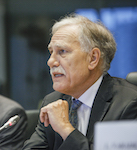
Why the European Defence Fund marks the Union’s age of reason
The Russian aggression of Ukraine has enacted a fundamental change in the way Europeans view their own security. In just a few hours following the invasion, countries across Europe announced radical policy changes, such as unprecedented increased defence spending. Now more than ever, it is time for Europe to gear up and equip itself with the means to defend its people and territory.
Recent policy developments at Union and global level, notably the implementation of harsh sanctions against the regime in Moscow, show that the EU is able to act united and decisively when the situation calls for it.
Beyond the upcoming measures that will be needed in the short term to de-escalate and limit the spread of the conflict, Europe will need to integrate assertive unilateral action at its border and beyond into its policy calculations.
Just a few days before the events in Ukraine, the Commission announced a new Defence package, outlining policy priorities to strengthen European defence policy. This Communication is only the latest signal of the EU’s increasing involvement in defence policy matters.
Amongst the many policy levers available, the European Defence Fund continues to feature most prominently, and understandably so, given the financial and political capital associated therewith.
The European Defence Fund is widely considered as the Union’s most significant institutional revolution when it comes to defence, which remains a purely national competence, until today. It is a game-changer leveraging on both EU and national funding to incentivise defence industry cooperation in Europe thus strengthening Europe’s strategic autonomy.
Legislators were first told the Union could not support military capability production. Never mind! The European Defence Fund found its legal base in the promotion of industrial competitiveness, an area where Member States share competence with the EU.
However, the genesis of the Fund was not without its contentions as it concerned the defence industry, closely intertwined with national sovereignty as well as philosophical considerations. In fact, the regulation underscores the Fund’s contribution to European strategic autonomy, a notion largely contested until not too long ago. Just as Parliament’s close vote at first reading reflects these complexities, the broad support to this flagship initiative in the new parliamentary term demonstrates a paradigm shift when it comes to strategic autonomy.
Europe’s defence industrial landscape is globally recognised for its excellence, with advanced know-how spanning a number of major capabilities (fighter jets, tanks, submarines and even spatial capacity).
However, Europe’s defence, technological and industrial base suffers from considerable fragmentation resulting in costly inefficiencies. If the military power of the EU was proportional to its Member States’ cumulative spending in defence, it would be the second player globally, behind the United States but before China (and far before Russia). The fact that 80% of defence procurement is run on a purely national basis has resulted in 178 different weapon systems in Europe – that is, six times more than the United States – with different levels of modernisation and interoperability. The Fund’s financial incentives for industrial consortia bringing together actors from across Member States, addresses the heart of the problem of fragmentation of Europe’s defence sector.
Moreover, the EU lags behind on a number of ground-breaking defence capabilities (for instance cyber and quantum technologies for defence) which will shape future combat whereas countries like the United States, China and Russia continue to invest heavily in future-proof solutions. The EU-managed Defence Fund constitutes Europe’s biggest asset in addressing these challenges. In fact, part of the Fund is dedicated to the co-funding of disruptive technologies in an effort to enhance the performance and resilience of defence equipment.
European armed forces remain extremely reliant, particularly on American solutions, for certain critical capabilities. This is compounded by the fact that military equipment produced in Europe often relies on American subcomponents, which are subject to extra-territorial regulations such as the ITAR[1].
This norm provides the United States with powerful leverage over a Member State’s decision over what to do with the equipment.
In a time when strategic planning was not at the top of the EU’s agenda, the European Defence Fund emerged as the biggest milestone towards enhancing European cooperation in the field of defence. Along with the military mobility programme, it is part of the building process of a coherent European strategic space. This ultimately contributes to the strengthening of EU strategic autonomy and technological sovereignty. While the final budget agreed upon is significantly less than what was initially expected (8 billion euros instead of 13 billion euros for 2021-2027), it allows the EU to embark on the path to maturity regarding security, 70 years after the failure of the European Defence Community. With that being said, the “return of tragedy in history” calls for going even further. A more ambitious fund, both financially and politically, would serve a more ambitious Europe. Let us wager that the supporters of a strong Europe will not have given up on the creation of a European DARPA[2] then.
________________________________
[1] International Traffic in Arms Regulations.
[2] Defence Advanced Research Projects Agency.




